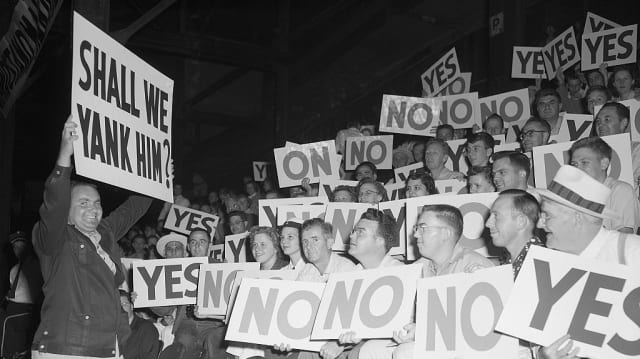The Wisdom of Crowds of Sports Fans?
It’s fun to go to a sporting event. You get to watch elite athletes do things that we normal folk can’t imagine doing. You can enjoy the energy of the crowd, the overpriced ballpark food and drink, and if you’re really dedicated, you and your (likely inebriated) friends can collect a lot of empty beer cups and make a “cup snake” to pass the time as well. All of that is to say that us fans are better off in the stands than we are on the field — we’re not throwing touchdowns, hitting homers, or scoring goals. We’re simply not as good as the players we’re paying to see.
But when it comes to the managers and coaches? Maybe that’s another story. Many fans — myself often included — think that at times, they’d be better strategists and tacticians than the people actually paid to do the job. But would we be?
If one 1950s experiment is any guess, perhaps the answer is “yes.”
The 1951 St. Louis Browns were one of the worst baseball teams of all time. Over a 154-game season, the Browns won only 52, ten fewer than the next-worst team. Few people even bothered to come to the Browns’ 77 home games; they sold only 290,000 tickets over the course of the season. (The second-worst drawing team, the Boston Braves, had 487,000 fans attend their games — and as a result, moved to Milwaukee just two years later.) As August approached and the season started to fade away, it was clear that the Browns weren’t going to win many games — and that fans weren’t really interested in paying to watch them lose.
So Bill Veeck, the team’s owner, decided to give the fans a more active role in the game. He made 4,000 of them the team’s managers. But only for a day.
On August 15, 1951, the Browns took out an ad, seen here, in a local newspaper, the St. Louis Globe-Democrat. Fans were invited to fill out a short form (attached to the ad) outlining which players they’d use, if it were up to the individual fan. Any fan who returned a completed form was entered into a lottery with two lucky entrants selected as the in-uniform managers for the August 24th game. Those who weren’t selected were given the chance to sit in a special section in the ballpark, dubbed “Manager’s Row. Whenever the in-uniform fan/managers had to make a decision, they’d hold up a sign in front of the grandstand managers, asking what to do. The grandstand managers were given “yes” and “no” signs, as seen below, and could vote for what the team would do. (The team’s actual manager, Zack Taylor, was effectively given the night off; per the ad, the team gave him a rocking chair and slippers and told him to just watch the game.)

Early in the game, the fans had a chance to make a pivotal decision. The Browns’ starting pitcher and best player, Ned Garver, got off to a rough start, giving up three runs early in the game. The fans voted to let him keep pitching, though, and that turned out well; Garver wouldn’t give up another run for the rest of the game. The fans also made a few other decisions that turned out nicely, including starting two backups over the typical starters. Ultimately, the Browns won the game, 5-3, over the Philadelphia Athletics. The Browns won only one out of every three games played under Zack Taylor, but the team was 1-0 — undefeated! — when managed by the fans.
Taylor wasn’t brought back the next year but the fans weren’t given another chance, either. The 1952 Browns fared not much better than their prior year’s counterparts, winning 64 games and finishing in second-to-last place. Despite the one-day success of fan managers, Bill Veeck’s experiment hasn’t been replicated.
Bonus fact: If you go to a Major League Baseball game, you’ll typically be warned to watch out for flying objects. Players often hit balls into the crowd and while it can be fun to catch one (so I’ve heard; I’ve never caught a foul ball), it can also be dangerous, particularly if you’re not ready for it. And while you’re unlikely to be injured, it definitely could happen. Just ask Alice Roth, a Philadelphia Phillies fan who was at the ballpark on August 17, 1957. That day, future Hall of Famer Richie Ashburn hit a foul ball that smacked into Roth’s nose, breaking it. The stadium staff brought out a stretcher and helped Roth leave the stadium, but before she could safely exit, Ashburn hit another foul ball — one which struck her in the leg. Her leg was okay and her nose eventually healed, and she ended up with a new friend in the process: Ashburn reached out to apologize, and the two stayed in touch thereafter.
From the Archives: How Baseball Closed Its Tiny Loophole: Another Bill Veeck story.
